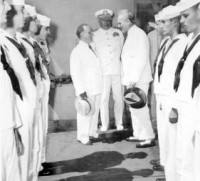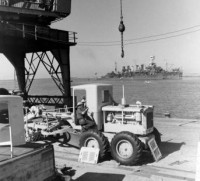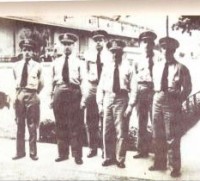MILITARY RELATIONS WITH BRAZIL BEFORE PEARL HARBOR - BRAZIL X USA MILITARY RELATIONS
8)SECURITY FORCE PLAN
At this point, the Army's concern for the security of the Brazilian bulge flared anew. Secret Nazi negotiations with Vichy's Admiral Darlan, climaxed on 15 May by a public announcement that Darlan had reached an agreement with Hitler, created a state of genuine alarm in Washington. German occupation of Dakar seemed imminent. On the morning of 16 May the chiefs of the War Plans and Military Intelligence Divisions, after conferring with each other, urged General Marshall to take immediate action on Brazil.
With Department of State approval, the Chief of Staff sent Colonel Ridgway to Rio de Janeiro that afternoon, with the mission of securing immediate Brazilian agreement to joint staff planning in Brazil and to dispatching United States Army forces to Northeast Brazil at the earliest possible moment. In conferences on 20 and 22 May, with Ambassador Caffery present, Colonel Ridgway conveyed his messages and the sense of urgency behind them, but he did not get any specific answer on either point.
Foreign Minister Aranha advised that only a strong personal appeal to President Vargas would be likely to secure Brazil's approval of these measures. By such an appeal, Brazilian consent was obtained on 31 May to sending an American Army joint staff planning group to Brazil, but the Foreign Minister, the Ambassador, and General Miller all advised Colonel Ridgway that President Vargas would not be likely to approve the stationing of American troops in Northeast Brazil unless President Roosevelt personally requested it. The Brazilians, Colonel Ridgway reported, were looking to Mr. Roosevelt for strong leadership--as also were the American Secretaries of War and Navy at this time.
In the meantime, the Army and Navy planning staffs in Washington were preparing for what appeared to be an imminent threat of American involvement in the war. On 22 May the Joint Plans and Projects Section of the Army's War Plans Division proposed the American garrisoning of naval and air bases in Northeast Brazil as the most immediately practicable move to counter the German threat. On the same day, President Roosevelt gave the Army and Navy a directive to prepare for the occupation of the Azores within thirty days. As between the Azores and Northeast Brazil projects, the Army planners unanimously favored the latter.
The most telling argument in its favor was that the establishment of a comparatively small, balanced American force on the shoulder of Brazil would be the most effective hemisphere defense measure that the United States could then undertake--indeed, the only one that it could undertake with any certainty of success. In cooperation with the Brazilian Army, small American forces could hold Northeast Brazil against a strong Axis attack--and an Axis force from Africa could not bypass the Brazilian bulge and attack any other South American position. With the Brazilian flank secure, the United States could prepare the great bulk of its forces for operations that might have to be undertaken in the decisive European theater.
After Colonel Ridgway's return to Washington, General Marshall directed him to draft a memorandum for Under Secretary of State Welles recommending immediate action to get troops into Brazil. On his own initiative Colonel Ridgway broadened the scope of his recommendations. In order, as he put it, "to avoid the fault line of cleavage which divides Portuguese speaking from Spanish speaking Latin America," he recommended that simultaneous requests be made to Mexico, Ecuador, Colombia, and Venezuela for permission to garrison bases within their territory, and also for unrestricted transit privileges for armed American aircraft. Other War Plans officers not only approved Colonel Ridgway's proposals but also thought them so urgent and important that they ought to go direct from the Chief of Staff or Secretary of War to the President. For this reason Colonel Ridgway's draft was converted into a Joint Planning Committee paper that, after Joint Board approval, would go directly to President Roosevelt.
This maneuver backfired. The chief Navy planner held that the Navy had no immediate interest in the use of Colombian, Venezuelan, or Ecuadoran ports, and preferred to negotiate separately with Mexico. The Navy, furthermore, had already obtained Brazil's approval for the use of the ports of Recife and Belém by surface vessels of the Atlantic patrol force. To the Army planners it seemed, "the Navy, having secured from Brazil permission for immediate use of its northeast harbors for such preparations as it may desire, does not see the urgency of the action we propose. From this point onward, the Army, in planning for Brazilian operations, had to cope with Navy as well as Department of State and Brazilian objections.
The immediate consequence was that the recommendations on Brazil jointly approved in early June were considerably milder than those desired by the Army. Even so, they stated forthrightly:
- That the present military situation is such as to warrant securing immediately the consent of the Government of Brazil to the movement of United States Army and Navy security forces to Northeast Brazil.
- That this permission should be secured now without waiting for an actual attack by a non-American power and a request for armed aid which, under existing staff agreements, are the conditions precedent to the entrance of United States armed forces into Brazil.
-
That permission be obtained concurrently for the transit of United States military armed aircraft across the territory and territorial waters of Colombia and Venezuela; and for the use of their airports, sea ports, and other facilities as may be necessary incident to such movement.
The Joint Board approved the recommendations on 7 June and formally transmitted them to the President six days later. A copy of the recommendations also went to Mr. Welles, who gave them his qualified approval at the Standing Liaison Committee meeting on 10 June. He thought Army troops could be introduced into Brazil "on a basis of participation in maneuvers."On 17 June General Marshall informed the Under Secretary that the Army wished to send a balanced force consisting of "aviation, antiaircraft artillery, infantry, field artillery, and service elements totaling approximately 9,300 troops and 43 planes," and that the Army and Navy were prepared to move this force on twenty days' notice.
The War Plans Division in the meantime had continued to urge a movement of Army troops to Brazil as the one above all others under consideration that would place an "effective bar to Axis penetration without {risking Army) involvement in major operations," that would provide the Latin Americans with an absolute assurance that the United States intended to implement real hemisphere defense, and that would also "serve as definite support to friendly South American governments now faced with very dangerous Axis political and subversive activities." On the morning of 19 June--three days before the German attack on the Soviet Union--Secretary Stimson drafted a letter to the President stating, "recent news from North Africa makes it very clear that we must act immediately to save the situation in Brazil.
"When Mr. Stimson talked with General Marshall about the matter, they decided it ought to be presented to the President in person at once. They did so the same morning, and President Roosevelt promised he would direct the Department of State to find ways and means of getting American troops into Brazil in the very near future. The President said that he thought the best way would be to get Brazil to offer the United States a limited lease on an Army air base site in the Natal region, and he proposed to talk with Mr. Welles along this line. Since General Marshall knew that the Department of State was as strongly opposed as the Latin Americans themselves were to the lease by the United States of military bases in other American nations, he had good reason for doubting the results of the President's directive to the Department of State.
The German attack on the Soviet Union on 22 June unquestionably had much to do with postponing the movement of American troops to Brazil. Nevertheless, though this attack ended the immediate threat of German penetration into West Africa, the Army still wanted to put a security force on the Brazilian bulge as soon as possible. Secretary Stimson considered that the new strategic situation provided the United States with a golden opportunity for securing "the protection of one hemisphere in the South Atlantic" as well as for strengthening the Anglo-American position in the North Atlantic. In early July Mr. Stimson wanted the President to announce the impending movement of Army troops to Brazil along with his public disclosure of the arrival of American forces in Iceland. General Gerow hoped to get the Army excused from participation in the Iceland occupation and to earmark the troops being prepared for that purpose as expeditionary forces for Brazil and other southern Atlantic danger points.
General Miller in Rio was instructed "to take every practicable measure to obtain the desired consent of the Brazilian Government" to the movement of the 9,300-man security force to the Natal area, ostensibly for participation in the Brazilian Army maneuvers scheduled for August and September 1941. Before this instruction reached him, General Miller reported that the Brazilian Chief of Staff had expressed an opinion that some sort of American participation in the maneuvers might be arranged, but he also stated that Foreign Minister
Aranha and Ambassador Caffery were opposed to the idea. This report led General Marshall once again to urge Mr. Welles to renewed efforts to attain the Army's objective, "upon which," the Chief of Staff noted, "you, Admiral Stark and I are all agreed, and which has the President's approval." The Under Secretary responded that President Roosevelt had addressed a personal and confidential message to President Vargas, that a reply to it was anticipated in the near future, and therefore that he thought it undesirable to take any new step to secure Brazilian consent to American participation in the maneuvers. Actually, the plan for immediately putting troops into Brazil had already been sidetracked, presumably because the changed strategic outlook had, from the nonmilitary point of view, reduced its urgency.
The scheme suggested in April of having a United States Army force participate in Brazilian maneuvers had contemplated sending auxiliary troops only, not infantry; the June plan, in contrast, proposed a balanced composite force built around an infantry regiment. Though Brazilian Army leaders had been cautiously receptive (though not enthusiastic) toward the first idea, they wanted no part of the second. After receiving General Marshall's memorandum of 17 June on the subject, Under Secretary Welles promptly informed Ambassador Caffery of the new security force proposal. When the Ambassador mentioned it informally to Foreign Minister Aranha, the latter "literally threw up his hands in consternation." Because of this reaction Mr. Caffery instructed General Miller not to engage in any discussion of the project with Brazilian military authorities, and General Miller himself characterized the June plan as "a wolf in sheep's clothing which seemed very dangerous and capable of producing a very unfavorable reaction in Brazil."
In a subsequent conversation with Ambassador Caffery, Mr. Aranha echoed the sentiment of Chief of Staff Goes Monteiro that under existing circumstances no Brazilian government could survive the approval of a proposition such as that advanced by the United States Army in June. The Brazilians avoided a direct refusal by abandoning their planned maneuvers.
President Roosevelt never did issue a clear directive to the Department of State to find ways and means of getting Army troops into Brazil, either during June or at any time before 7 December 1941. The personal message that Mr. Roosevelt finally sent to President Vargas on 10 July did not even mention the possible movement of Army troops to Brazil. Instead, it embodied Ambassador Caffery's suggestion that Brazil be asked to agree to the use of token Brazilian forces to help guard Dutch Guiana and the Azores, and President Vargas gave his consent to this proposal.
But this approach, designed to lead to an exchange of Brazilian and American defense forces, accomplished nothing. A subsequent proposal to put a contingent of Brazilian troops into Puerto Rico likewise came to naught, since for technical reasons neither the Brazilian nor the American Army regarded it with any enthusiasm. In effect, then, the Army failed to persuade President Roosevelt to make the strong personal appeal to President Vargas that the situation had seemed to warrant from the military point of view.
As soon as it began to appear that the security force plan was being stalemated, Colonel Ridgway suggested a new scheme: first, the Navy would obtain Brazilian permission to base patrol planes at Natal; then, with Brazil's consent, the Navy would request the assistance of Army long-range reconnaissance planes of the B-17 type; upon the arrival of the B-17's, the Navy would provide a Marine Corps detachment to guard the Army planes; and, finally (again, with Brazilian consent), Army security detachments would replace the Marine Corps guards. The Navy promptly approved the plan, and until 1942 supported it as the best way to get Army troops into Brazil. For nearly two months after this exchange, the Army held its own troop movement plan in abeyance, awaiting the outcome of Department of State and Navy negotiations.
Transcribed by Patrick Clancey – Hyper War Foundation



